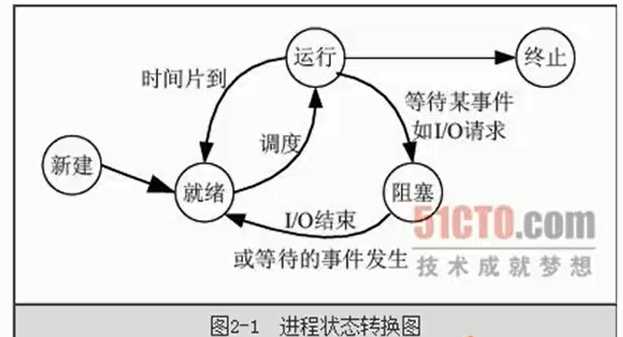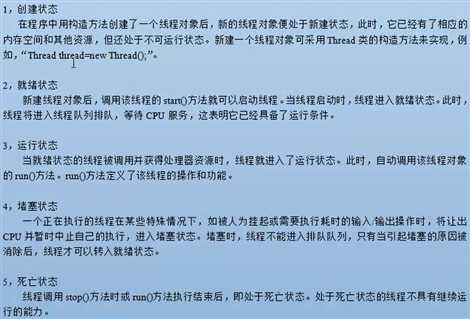标签:pack nis generated cep 不能 i++ 继承 eth cat
一、线程的引入:
定义:同时对多项任务加以控制
我们上下代码:
1.未使用线程
1 package com.learn.chap08.sec01; 2 /** 3 * 未使用线程--同步执行 4 * @author Administrator 5 * 6 */ 7 public class Demo1 { 8 9 /** 10 * 听音乐 11 */ 12 public static void music(){ 13 for (int i = 0; i < 5; i++) { 14 System.out.println("听音乐"); 15 } 16 } 17 18 /** 19 * 吃饭 20 */ 21 public static void eat(){ 22 for (int i = 0; i < 5; i++) { 23 System.out.println("吃饭"); 24 } 25 } 26 27 public static void main(String[] args) { 28 music(); 29 eat(); 30 } 31 }
2. 使用线程
1 package com.learn.chap08.sec01; 2 /** 3 * 使用多线程--异步执行 4 * @author Administrator 5 * 6 */ 7 public class Eat extends Thread{ 8 9 @Override 10 public void run() { 11 for (int i = 0; i < 5; i++) { 12 try { 13 Thread.sleep(100); // 100毫秒 14 } catch (InterruptedException e) { 15 // TODO Auto-generated catch block 16 e.printStackTrace(); 17 } 18 System.out.println("吃饭"); 19 } 20 } 21 22 }
1 package com.learn.chap08.sec01; 2 /** 3 * 使用多线程--异步执行 4 * @author Administrator 5 * 6 */ 7 public class Music extends Thread { 8 9 @Override 10 public void run() { 11 // TODO Auto-generated method stub 12 for (int i = 0; i < 5; i++) { 13 try { 14 Thread.sleep(100); 15 } catch (InterruptedException e) { 16 // TODO Auto-generated catch block 17 e.printStackTrace(); 18 } 19 System.out.println("听音乐"); 20 } 21 } 22 23 }
1 package com.learn.chap08.sec01; 2 /** 3 * 使用多线程--异步执行 4 * @author Administrator 5 * 6 */ 7 public class Demo2 { 8 public static void main(String[] args) { 9 /** 10 * 利用多线程--实现一边听音乐 一边吃饭 11 */ 12 Music musicThread = new Music(); 13 Eat eatThread = new Eat(); 14 musicThread.start(); 15 eatThread.start(); 16 } 17 }
二、使用多线程
1. 继承Thread类
代码如下:
1 package com.learn.chap08.sec02; 2 3 public class Thread1 extends Thread { 4 private String threadName; 5 private int baoZi = 1; 6 7 public Thread1(String threadName) { 8 super(); 9 this.threadName = threadName; 10 } 11 12 @Override 13 public void run() { 14 // TODO Auto-generated method stub 15 while(baoZi<=10){ 16 System.out.println(this.threadName+" 吃第"+baoZi+"个包子"); 17 baoZi++; 18 } 19 } 20 21 public static void main(String[] args) { 22 System.out.println("张三、李四各自吃10个包子"); 23 Thread1 t1=new Thread1("张三线程"); 24 Thread1 t2=new Thread1("李四线程"); 25 t1.start(); 26 t2.start(); 27 } 28 29 }
2. 实现Runnable接口
代码如下:
1 package com.learn.chap08.sec02; 2 3 public class Thread2 implements Runnable{ 4 5 private String threadName; 6 private int baoZi = 1; 7 8 public Thread2(String threadName) { 9 super(); 10 this.threadName = threadName; 11 } 12 13 @Override 14 public void run() { 15 // TODO Auto-generated method stub 16 while(baoZi<=10){ 17 System.out.println(this.threadName+" 吃第"+baoZi+"个包子"); 18 baoZi++; 19 } 20 } 21 22 public static void main(String[] args) { 23 System.out.println("张三、李四各自吃10个包子"); 24 Thread1 t1=new Thread1("张三线程"); 25 Thread1 t2=new Thread1("李四线程"); 26 Thread t11=new Thread(t1); 27 Thread t12=new Thread(t2); 28 t11.start(); 29 t12.start(); 30 } 31 32 }
1 package com.learn.chap08.sec02; 2 3 public class Thread3 implements Runnable{ 4 5 private String threadName; 6 private int baoZi = 1; 7 8 public Thread3(String threadName) { 9 super(); 10 this.threadName = threadName; 11 } 12 13 @Override 14 public synchronized void run() { 15 // TODO Auto-generated method stub 16 while(baoZi<=10){ 17 System.out.println(this.threadName+" 吃第"+baoZi+"个包子"); 18 baoZi++; 19 } 20 } 21 22 public static void main(String[] args) { 23 24 Thread3 t1=new Thread3("超级张三线程"); 25 26 Thread t11=new Thread(t1); 27 Thread t12=new Thread(t1); 28 Thread t13=new Thread(t1); 29 // 实现资源共享 30 t11.start(); 31 t12.start(); 32 t13.start(); 33 } 34 35 }
总结: Runnable接口 可以实现资源共享 而Thread不能。
三、线程状态


四、多线程常用的方法

举例代码如下:
1 package com.learn.chap08.sec04; 2 3 public class Demo1 implements Runnable{ 4 5 @Override 6 public void run() { 7 // TODO Auto-generated method stub 8 for (int i = 0; i < 10; i++) { 9 // 获取当前线程 10 Thread t=Thread.currentThread(); 11 System.out.println(t.getName()+":"+i); 12 } 13 14 } 15 16 public static void main(String[] args) { 17 Demo1 demo1 = new Demo1(); 18 new Thread(demo1).start(); 19 new Thread(demo1,"线程一").start(); 20 new Thread(demo1,"线程二").start(); 21 22 Thread it = new Thread(demo1); 23 System.out.println(it.isAlive()); 24 it.start(); 25 System.out.println(it.isAlive()); 26 } 27 28 }
运行结果
false
true
Thread-1:0
Thread-1:1
Thread-1:2
Thread-1:3
Thread-1:4
Thread-1:5
Thread-1:6
Thread-1:7
Thread-1:8
Thread-1:9
线程二:0
线程二:1
线程二:2
线程二:3
线程二:4
线程二:5
线程二:6
线程二:7
线程二:8
线程二:9
Thread-0:0
Thread-0:1
Thread-0:2
Thread-0:3
Thread-0:4
Thread-0:5
Thread-0:6
Thread-0:7
Thread-0:8
Thread-0:9
线程一:0
线程一:1
线程一:2
线程一:3
线程一:4
线程一:5
线程一:6
线程一:7
线程一:8
线程一:9
1 package com.learn.chap08.sec04; 2 3 public class Demo2 implements Runnable{ 4 5 @Override 6 public void run() { 7 // TODO Auto-generated method stub 8 for (int i = 0; i < 10; i++) { 9 try { 10 Thread.sleep(1000); // 线程休眠 11 // 获取当前线程 12 Thread t=Thread.currentThread(); 13 System.out.println(t.getName()+":"+i); 14 } catch (InterruptedException e) { 15 // TODO Auto-generated catch block 16 e.printStackTrace(); 17 } 18 19 } 20 21 } 22 23 public static void main(String[] args) { 24 Demo2 demo1 = new Demo2(); 25 new Thread(demo1).start(); 26 new Thread(demo1,"线程一").start(); 27 } 28 29 }
运行结果
Thread-0:0
线程一:0
Thread-0:1
线程一:1
.
.
.
1 package com.learn.chap08.sec04; 2 3 public class Demo3 implements Runnable{ 4 5 @Override 6 public void run() { 7 // TODO Auto-generated method stub 8 for (int i = 0; i < 10; i++) { 9 // 获取当前线程 10 Thread t=Thread.currentThread(); 11 System.out.println(t.getName()+":"+i); 12 13 } 14 15 } 16 17 public static void main(String[] args) { 18 Demo3 demo1 = new Demo3(); 19 Thread t1 = new Thread(demo1,"线程一"); 20 Thread t2 = new Thread(demo1,"线程二"); 21 Thread t3 = new Thread(demo1,"线程三"); 22 t1.setPriority(Thread.MAX_PRIORITY); // 更改线程的优先级 23 t2.setPriority(Thread.NORM_PRIORITY); 24 t3.setPriority(Thread.MIN_PRIORITY); 25 t1.start(); 26 t2.start(); 27 t3.start(); 28 } 29 30 }
1 package com.learn.chap08.sec04; 2 3 public class Demo4 implements Runnable{ 4 5 @SuppressWarnings("static-access") 6 @Override 7 public void run() { 8 // TODO Auto-generated method stub 9 for (int i = 0; i < 10; i++) { 10 try { 11 Thread.sleep(100); 12 // 获取当前线程 13 Thread t=Thread.currentThread(); 14 System.out.println(t.getName()+":"+i); 15 if(i==5){ 16 System.out.println("线程礼让:"); 17 Thread.currentThread().yield();// 出现@SuppressWarnings("static-access") 18 } 19 } catch (InterruptedException e) { 20 // TODO Auto-generated catch block 21 e.printStackTrace(); 22 } 23 } 24 } 25 26 public static void main(String[] args) { 27 Demo4 demo1 = new Demo4(); 28 Thread t1 = new Thread(demo1,"线程一"); 29 Thread t2 = new Thread(demo1,"线程二"); 30 t1.start(); 31 t2.start(); 32 } 33 34 }
运行结果
线程一:0
线程二:0
线程一:1
线程二:1
线程一:2
线程二:2
线程二:3
线程一:3
线程一:4
线程二:4
线程一:5
线程礼让:
线程二:5
线程礼让:
线程一:6
线程二:6
线程一:7
线程二:7
线程一:8
线程二:8
线程一:9
线程二:9
五、线程同步
1. 同步方法
2. 同步锁(锁机制)
上下代码:
1 package com.learn.chap08.sec05; 2 3 public class Demo2 implements Runnable{ 4 5 private int baoZi=10; 6 7 @Override 8 /** 9 * 同步方法 10 */ 11 public synchronized void run() { // 用synchronized标识 的方法为同步方法 不加锁的话,下面的张三、李四、王五可能会同时进入run()方法 12 // TODO Auto-generated method stub 13 while(baoZi>0){ 14 System.out.println(Thread.currentThread().getName()+"吃了第"+baoZi+"个包子"); 15 baoZi--; 16 } 17 } 18 19 public static void main(String[] args) { 20 Demo2 demo1=new Demo2(); 21 new Thread(demo1,"张三").start(); 22 new Thread(demo1,"李四").start(); 23 new Thread(demo1,"王五").start(); 24 } 25 26 }
1 package com.learn.chap08.sec05; 2 3 public class Demo3 implements Runnable{ 4 5 private int baoZi=10; 6 7 @Override 8 public void run() { 9 /** 10 * 同步块 11 */ 12 synchronized (this) { // 同步块 13 while(baoZi>0){ 14 System.out.println(Thread.currentThread().getName()+"吃了第"+baoZi+"个包子"); 15 baoZi--; 16 } 17 } 18 } 19 20 public static void main(String[] args) { 21 Demo3 demo1=new Demo3(); 22 new Thread(demo1,"张三").start(); 23 new Thread(demo1,"李四").start(); 24 new Thread(demo1,"王五").start(); 25 } 26 27 }
下面举例:java synchronized同步方法调用另一个同步方法,锁机制问题
1 public synchronized void methodA(int a, int b); 2 3 public synchronized void methodB(int a){ 4 methodA(a, 0); 5 }
标签:pack nis generated cep 不能 i++ 继承 eth cat
原文地址:http://www.cnblogs.com/eaglezb/p/6011361.html